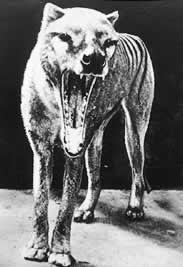The earth has always been home to incredible creatures. This is a list of the 10 most amazing animals which once ruled the planet earth.
Tyrannosaurus Rex
Tyrannosaurus, meaning the "tyrant lizard, is probably the best known of all the dinosaurs. It lives in our imagination, with its massive jaws and threatening figure, as the perfect monster. That is probably why we named it "Rex", meaning the "King".
The Tyrannosaurus Rex, or T. Rex for short, wandered the earth about 65 million years ago. With a height of upto 16.6 ft and weighing at a massive 7 tons, the T. Rex was the largest land carnivore ever existed. Fossils of T. Rex have been discovered in rock fossils in North America, dating back to the Cretaceous Period. The last T. Rex died out 66 million years ago, much earlier than any human feet trampled land.
Sabre Toothed Tiger
The sabre toothed tiger roamed the earth about 40 million years ago. It was much bigger then its modern descendants and had a bear like build. It was an excellent hunter, hunting giant animals including mammoths, sloth, even prehistoric men. The sabre toothed tiger went extinct about 10000 years ago, at the end of the last ice age. Although the definite causes are unknown, it is believed that climatic changes and disappearance of prey spelled its doom.
Gigantopithecus
It ruled the forests around 500,000 years ago. The giant ape lived on bamboos, occasionally feeding on seasonal fruits. It died out around 10,000 years ago as a result of climatic changes.
Terror Bird
The terror bird stood at a remarkable 6 ft and weighed as much as 300 pounds. They were blessed with large hatchet like bills which tore apart mammals, reptiles and other birds.
Fossils of these large prehistoric birds of prey have been collected from a former sinkhole in the Santa Fe River, Gilchrist County, Florida. No terror bird fossils were younger than 2 million years, suggesting it became extinct early in the Pleistocene period.
Tasmanian Tiger
Dodo
The phrase: "As dead as a Dodo", is used for something that has become extinct. But what exactly is a Dodo? The dodo is a big fat bird which once roamed the islands of Mauritius in the Indian ocean. The dodo was a large, flightless bird which stood at around 1 metre. It had a large hooked beak, lived on fruits and nested on the ground. The dodo was hunted to extinction by sailors who landed on the islands. Since, the bird was found no where else, it soon died out and became extinct in late 17th century.Pyrenean Ibex
But this was not the end. Due to extensive cloning, scientists were able to brought them back to life, the first animal ever to be resurrected through cloning. Unfortunately the cloned specimen couldn't survive for more than 7 minutes due to lung failure.
Megalodon Shark
The great shark went extinct around 1.6 million years ago during the Cenozoic Era. While the exact causes remain unknown, climatic changes are believed to play a crucial role.
Stellar Sea Cow
With its large body, small head, stout limbs and whale-like tail, the sea cow resembled modern seals. The creature was once widespread in the areas around the north Pacific coast but human settlement in the area resulted in rapid decrease in its numbers and the last specimen died in 1768. This makes it one of the more recently extinct animals in our list.
Haast's Eagle
The reign of the giant raptor continued till 1400, until the Maori people settled in the area who hunted the moa, it's chief prey, to extinction. As a result, the Haast's eagle soon died out.
Further Reading:
There is no end to history. If you want to learn more about these extinct animals and many other ones, then this encyclopaedia can be your complete answer. It covers everything from the first microscope sea creatures to the Tasmanian wolf. Each chapter covers the animals themselves, the processes that brought them to extinction, and the modern scientific discoveries that reveal their lost words.
Buy it: Dinosaurs to Dodos: An Encyclopedia of Extinct Animals














